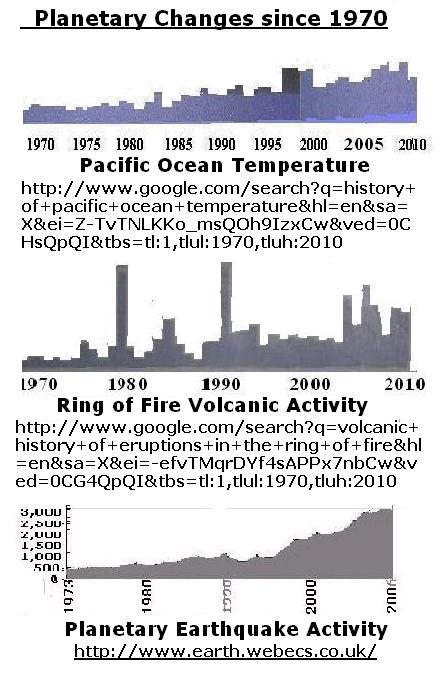
Our Klamath Basin Water Crisis
Upholding rural Americans' rights to grow food,
own property, and caretake our wildlife and natural resources.

Our Klamath Basin
Water Crisis
Upholding rural Americans' rights to grow food,
own property, and caretake our wildlife and natural resources.
|
Planetary Changes since 1970 
Let’s look at
Global Warming
By: Dr. Richard Gierak Synopsis Global advocates have attempted to blame rising planetary temperatures are as a result of human activity. The following articles will demonstrate that we are looking at a natural planetary cycle where carbon dioxide is rising in the atmosphere due to ocean warming, volcanic activity and earthquake data which all correlate with each other. Pacific Ocean Temperature and Carbon Dioxide Since the 1700’s we have seen small changes in the Pacific Ocean temperatures. Based on NMFS El Nino and La Nina data they refer to rises as much as 2.8 degrees. However; Since the 1970’s we have seen a historic rise in the Pacific Ocean temperature that could reach a 10 degree warming trend. This historic rise in temperature of the Pacific Ocean is directly related to large amounts of carbon dioxide being released into the atmosphere. For eons, the world’s oceans have been sucking carbon dioxide out of the atmosphere and releasing it again in a steady inhale and exhale. The ocean takes up carbon dioxide through photosynthesis by plant-like organisms (phytoplankton), as well as by simple chemistry: carbon dioxide dissolves in water. It reacts with seawater, creating carbonic acid. Carbonic acid releases hydrogen ions, which combine with carbonate in seawater to form bicarbonate, a form of carbon that doesn’t escape the ocean easily As temperatures rise, carbon dioxide leaks out of the ocean like a glass of root beer going flat on a warm day. Carbonate gets used up and has to be re-stocked by upwelling of deeper waters, which are rich in carbonate dissolved from limestone and other rocks. It becomes apparent that with the historic rise of the Pacific Ocean temperature that massive amounts of carbon dioxide are released into the atmosphere. The following link will take you to the Pacific Ocean temperature data from the 1700’s to the present date: http://www.google.com/search?q=history+of+pacific+ocean+temperature&hl=en&sa=X&ei=yFPwTODlNIm-sQPfru24Cw&ved=0CHsQpQI&tbs=tl:1,tlul:1700,tluh:2010The following link will take you to the NASA data on carbon dioxide release:. http://earthobservatory.nasa.gov/Features/OceanCarbon/Ring of Fire volcanic activity Since the 1700’s we have seen little change in volcanic activity with an occasional spike with a large eruption. However, since the early 1970’s we have seen a historic rise in volcanic activity throughout the Pacific Ring of Fire. The interesting point is that the graphic representation of volcanic activity in the Pacific correlates with the historic rise in temperature of the Pacific Ocean. It would not be a great leap to make the statement that the historic rise in volcanic activity has been the driving force behind the historic rise in the Pacific Ocean temperature releasing massive amounts of carbon dioxide. See the following link to view the graphic representation of volcanic activity since the 1700’s to present day in the Pacific Ring of Fire: http://www.google.com/search?q=volcanic+history+of+eruptions+in+the+ring+of+fire&hl=en&sa=X&ei=K4PVTKWHHI7WtQPH4ISNCw&ved=0CG0QpQI&tbs=tl:1,tlul:1700,tluh:2010Planetary Earthquake activity It might be of interest to note that planetary earthquake activity has also reached historic levels throughout our planet with even larger quakes. Since 1973 we have seen a significant increase of earthquake activity throughout the planet. We might surmise that earthquake activity would also be linked to volcanic activity on our planet. The following link will clearly show that we are seeing a massive increase in earthquake activity. Admittedly, a portion of the increase is accounted for by the increase of earthquake sensors around our planet, however, they do not account for this historic rise. The following link will take you to an analysis of global earthquake activity: http://www.earth.webecs.co.uk/Glacier growth Scientists say a warming Pacific Ocean means more moist air sweeping over far Northern California. Because of Shasta's location and 14,162-foot elevation, the precipitation is falling as snow, adding to the mass of the mountain's glaciers. Shasta's glaciers have been advancing since the end of a drought in the early 20th century. The mountain's smallest glaciers — named Konwakiton, Watkins and Mud Creek — have more than doubled in length since 1950. Shasta's largest glacier, the Hotlum, grew more than 600 yards between 1944 and 2003 and covers nearly 2 square miles of the mountain's northeastern face. The Whitney glacier grows up to 4 inches a day in winter and is about 2.4 miles long. Until recently, the same phenomenon that is now benefiting Shasta's glaciers was feeding glacier growth in southern Norway and Sweden, the New Zealand Alps and northern Pakistan, according to the U.N. Intergovernmental Panel on Climate Change. The following link will take you to the article regarding Shasta’s glaciers. http://www.usatoday.com/tech/science/environment/2008-07-08-mt-shasta-growing-glaciers_N.htmConclusions: After reviewing this data I believe that you can begin to see that “global warming” is a natural planetary cycle phenomenon and not as a result of human activity.
|
Page Updated: Saturday November 27, 2010 12:11 AM Pacific
Copyright © klamathbasincrisis.org, 2010, All Rights Reserved